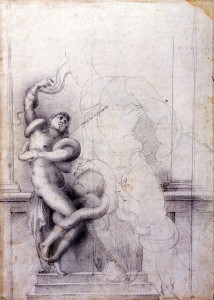 The Photographic Collection of the Bibliotheca Hertziana has been responsible for the care of and access to Walter and Jutta Gernsheim’s Corpus Photographicum of Drawings since 2002. The Corpus includes over 190,000 photographs of Old Master drawings, architectural drawings and drawings after antiquities, which originate mainly from the 16th and 17th centuries and subsequent periods. The project has been accompanied by annual conferences and summer courses y on the research of drawings since 2012.
The Photographic Collection of the Bibliotheca Hertziana has been responsible for the care of and access to Walter and Jutta Gernsheim’s Corpus Photographicum of Drawings since 2002. The Corpus includes over 190,000 photographs of Old Master drawings, architectural drawings and drawings after antiquities, which originate mainly from the 16th and 17th centuries and subsequent periods. The project has been accompanied by annual conferences and summer courses y on the research of drawings since 2012.
The focus of this year’s Gernsheim Conference is the exploration of sculptural works through the medium of drawing, the beginnings of which emerged in the early 15th century. The practice experienced an initial high point in the 16th century before culminating in the increasingly regulated academisation of the 17th century. The aim of the conference is to undertake a methodological analysis of the graphic artist’s view of sculpture – whether in a sketch, a study or the adaptation and interpretation of a three-dimensional object – and designate it in terms of its mediality. This process can be carried out on the basis of case studies of individuals or groups and through comparative perspectives or synchronic/diachronic analyses of concrete phenomena. No limits are set regarding the country of origin of the graphic artists and the contexts in which the sculptural works that acted as models emerged (Antiquity or contemporary sculpture). The Renaissance provides the temporal framework for the drawings to be examined.
The following questions may be considered:
– What role do the studies assume in the artistic process? Are the drawings under consideration studies for sculptures or do they show executed works? Which criteria can be identified for differentiating between them?
– Which aesthetic and intellectual processes can be observed in the transformation of the model form into different media?
– Which functions can drawings after sculptures assume, for example as products of artistic training or as components of repositories of visual knowledge? To what extent are they or do they become creations of productive reception and transformation, and, therefore, the starting point for new works?
– Which preferences of selection and practices of appropriation can be observed? Which characteristics of the study objects, e.g. of an iconographic, material or stylistic nature, are perpetuated in the drawing, and which are highlighted, neglected or ignored?
– What is the context of the models, which processes of re-dedication and re-interpretation arise? Questions should be explored, for example, regarding the study of three-dimensional figures as the equivalent of that of the human nude or that of relief composition and their adoption in new narrative contexts.
Attention should also be focused on aspects of drawing materials and techniques and theoretical discussions on the study of sculpture from Alberti to van Mander.
Keynote-Speaker: Prof. Dr. Michael Cole (Columbia University New York)
Please send your exposé and CV to Dr. Tatjana Bartsch (bartsch@biblhertz.it) and Dr. Johannes Röll (roell@biblhertz.it) by 6 April 2015.
The Bibliotheca Hertziana will cover the travel costs (economy class) and accommodation in accordance with the provisions of the German Travel Expenses Act (Bundesreisekostengesetz).
Renaissance Drawings for and after Sculpture
Gernsheim Conference at the Bibliotheca Hertziana
11–13 November 2015

Leave a Reply
You must be logged in to post a comment.